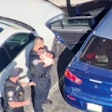Editorial:
I’m going to talk about what every American law enforcement officer needs to remember about 9/11. Remember the horror. Remember the heroism. Remember the way it stunned and briefly united the nation. But most of all, remember it could have been prevented.
There were so many warning signs flashing before 9/11. The terrorists told us exactly what they planned to do. They had even already tried to do it.
On Feb. 26, 1993, terrorists set off a truck bomb below the North Tower of the World Trade Center. Six people were killed and more than a thousand were injured. But we quickly forgot about it. The only part of the story anybody wanted to talk about was the idiot conspirator who tried to get his deposit back on the rental truck by claiming it was stolen and was captured because investigators found the VIN of the vehicle in the debris.
What they should have been paying attention to was the words of the bombing’s mastermind Ramzi Yousef (real name believed to be Abdul Basit Mahmoud Abdul Karim), who was captured in Pakistan in 1995 and brought back to the U.S. At his 1997 trial he revealed that the goal of the bombing was to topple the North Tower into the South Tower and bring them both down, killing 250,000 Americans. They even made an HBO movie about the attack and it’s final scene is chilling. At the end of that 1997 movie, Yousef is being transferred on an FBI helicopter high above New York City. He looks out over the World Trade Center towers and says, “Next time we bring them all down.”
Plans to use airplanes as terrorist weapons were already underway by the time that movie was showing on cable. In 1995, Philippine National Police uncovered the Bojinka Plot. That plan from the extremely dangerous minds of Ramzi Yousef and his uncle Khalid Sheikh Mohammed was a three-stage terror campaign. The plan was to assassinate Pope John Paul II during a visit to the Philippines; blow up 11 airliners flying from Asia to the United States with an estimated death toll of 4,000; and rent a plane, fill it with explosives, and crash it into CIA Headquarters. Khalid Sheikh Mohammed, one of the leaders of the Bojinka Plot, would later plan and organize the 9/11 attacks.
The Bojinka Plot also brought Osama bin Laden to the forefront of terror threats facing the United States. It’s not that bin Laden was unknown before the Philippine arrests. But he started to be taken a lot more seriously after it was discovered that he had financed the plot. In 1996, the CIA launched a special unit called the Bin Laden Issue Station.
The purpose of the CIA’s special Bin Laden Issue Station was to gather intelligence about the man and al Qaeda, the terror organization he founded in 1988. It also ran operations against him, monitored his finances, and provided information about him to political leaders.
Bin Laden launched major attacks on U.S. interests overseas in the late 1990s. In 1998, al Qaeda bombed the U.S. embassies in Kenya and Tanzania. At the time the intelligence community warned President Bill Clinton that bin Laden was training personnel to hijack multiple aircraft.
There were so many other warnings, so many missed opportunities. Multiple U.S. allies informed American officials that bin Laden was planning something big that would use hijacked aircraft as missiles. Even a Taliban minister reportedly tried to warn UN officials in Afghanistan that a huge attack was planned on America. He reportedly sent the warning because he was worried about America’s response. All of the warnings were ignored. Worse, the U.S. had bin Laden in its sights before 9/11 and Bill Clinton chose not to pull the trigger because the strike would have killed civilians.
The lesson here is that Americans ignore threats at risk of great calamity. We’ve were at war for 20 years because of the 9/11 attack. Thousands of Americans, allies, and civilians were killed and maimed in that war. We lost 3,000 people on 9/11. We’ve lost trillions of dollars to the attack and its aftermath. We’ve spent trillions in the war. And it all could have been avoided.
America has always benefited from its isolation from the rest of the world. Our enemies once had to cross the oceans to attack us. That gives us a false sense of security. But we can no longer afford to believe we are secure, especially in the age of terrorism and now cyberterrorism. We have to be constantly on guard. It’s commonly said by law enforcement trainers that complacency kills. That’s true on the international level as well. Which is the one thing that we can’t afford to forget about 9/11.

















